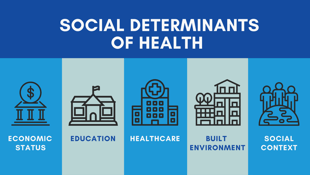How Social Determinants of Health Shape Outcomes in Value-Based Care
For the past ten years social determinants of Health (SDoH) have gained greater importance from health care organizations and legislators, and the...
.png)

COVID-19 has reignited the conversation regarding social determinants of health (SDoH) as certain minority groups are at a greater risk for contracting it and experiencing worse outcomes due to their living, work, and health circumstances.
The role of social determinants in care outcomes can’t be denied. Clinical care influences just 10 to 20 percent of a patient outcomes, the rest being impacted by SDoH. SDoH are factors that indirectly contribute to healthcare outcomes, including behavioral health, socioeconomic status, education, physical environment, employment, and social environment. Looking even closer we can see how factors like transportation, education level, and access to food¾among many other things¾relate to overall health and can compound on one another.
Social determinants of health represent an estimated 1.7 trillion dollars of avoidable healthcare costs. As bleak as it may seem, this presents an opportunity to transform the patient experience and the cost of care by going beyond clinical care, but also addressing unmet social needs that lead to cost overutilization or delayed care.
-1.png?width=770&name=SDoH-enhanced-graphic%20(Horizontal)-1.png)
Collect Patient Information (Have your ear to the ground)
Work with your provider network to implement screening tools to identify health-related social needs. In a survey of nearly 300 hospitals and health systems conducted by the Deloitte Center for Health Solutions in 2017, almost 9 in 10 (88%) hospitals screen patients to gauge their health-related social needs, though only 62% report screening target populations in a systematic or consistent way.
Providers can screen for SDoH in a variety of ways, including paper questionnaires, conversation, or by utilizing publicly available information which gives context to where the patient lives and works. They may also be able to use data from the Census or American Community Survey on neighborhood-level demographic information and links this to the patient’s home address under the assumption that it is reflective of the patient.
Regardless of how SDoH information is collected, it’s essential that it is incorporated into patient medical records in order to inform clinical decision-making. In the same way a physician can view a patient’s previous medical diagnoses and use it to inform care, a physician’s access to a patient’s SDoH can provide context for treatment options.
Create Workflows & Align Your Network (Report back what you hear)
When developing workflows, you want to establish clear roles and responsibilities. You want to determine who is screening, recording, providing intervention, tracking performance, and who is developing community relationships and compiling resources. When roles and accountability are clearly defined, everyone along the continuum of care is more likely to buy-in.
Just like you need to build relationships with your providers to succeed, you also need to build relationships with community-based organizations (CBOs). You want to set goals and track progress with your CBOs. Work together to identify key community metrics and commit to achieving them both on an individual and collective level. For example, you can share data in order to plan care and allocate resources based on the results of providers’ patient screenings of social determinants.
In addition, you want the entire care team to be aligned. This isn’t just essential for success in VBC, but is essential for addressing SDoH. Everyone involved along the continuum of care has unique responsibilities, but acts within a moving network tasked with unified goals—healthier patients, better outcomes, lower costs, and higher quality care.
Outside of providers—social workers, CBOs, and other stakeholders—all require access to role-defined patient-level data to make the most impact. Without this alignment, accountability and responsibility can slip through the cracks and lead to worse outcomes and higher costs.
You also want to leverage data sharing so you can extrapolate and use data in new and creative ways to understand performance as well as use it as a means of reporting to communities and local officials.
Social determinants of health offer a wealth of information that affects the impact, cost, and quality of care received. By incorporating SDoH in your value-based care initiatives, you can not only generate cost savings by reducing avoidable healthcare costs, but also positively impact the communities you serve.
.png?height=150&name=SpectraMedix%20-%20Stacked%20Logo%20(1).png)

For the past ten years social determinants of Health (SDoH) have gained greater importance from health care organizations and legislators, and the...

The large majority of American land is rural, so it can often feel like a daunting task to define which populations are...